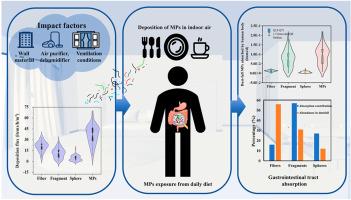室内降尘微塑料的特征、影响因素及风险评估:强调碎片化形式的风险升高
IF 3.7
2区 环境科学与生态学
Q2 ENVIRONMENTAL SCIENCES
引用次数: 0
摘要
微塑料(MPs)是一种重要的环境污染物,室内环境既是人体接触这些颗粒的来源,也是人体接触这些颗粒的媒介。不同形状的MP对健康风险的影响,特别是对肠道吸收的影响,仍然知之甚少。本研究调查了室内降尘中的MPs,重点是形状依赖的特征和风险。采用密度分离、显微技术和微傅里叶变换红外光谱(μ-FTIR)对城市居民住区降尘样品进行了分析。我们的研究结果表明,降尘MPs由碎片状、纤维状和球形组成,其中碎片状MPs占总数的31%。由于其更大的比表面积(SSA),破碎MPs表现出更高的吸收能力。建立了人体肠道对室内粉尘中MPs的吸收健康风险模型,结果表明,颗粒状MPs的吸收率最高(0.0289),其次是球形MPs(0.0136)和纤维MPs(0.0088)。室内调查进一步表明,选择低排放墙体材料、增加通风和使用空气净化器等做法可以降低室内MP水平。我们的研究结果强调了在风险评估和缓解战略中针对分散的国会议员的重要性。本文章由计算机程序翻译,如有差异,请以英文原文为准。

Characteristics, influencing factors, and risk assessment of indoor dustfall microplastics: Emphasizing the elevated risks of fragmented forms
Microplastics (MPs) are a significant environmental pollutant, and the indoor environment serves as both a source and a medium for human exposure to these particles. The influence of different MP shapes on health risks, particularly concerning intestinal absorption, remains poorly understood. This study investigated MPs in indoor dustfall, with an emphasis on shape-dependent characteristics and risks. Dustfall samples from urban residences were analyzed using density separation, microscopy, and micro-Fourier-transform infrared spectroscopy (μ-FTIR). Our findings showed that the dustfall MPs consisted of fragmented, fibrous, and spherical shapes, with fragmented MPs accounting for 31 % of the total. Due to their larger specific surface area (SSA), fragmented MPs exhibited a higher absorption capacity. A health risk model for human intestinal absorption of MPs in indoor dustfall was developed, revealing that fragmented MPs contributed the highest absorption rate (0.0289), followed by spherical MPs (0.0136) and fibers (0.0088). Indoor surveys further indicated that practices such as choosing low-emission wall materials, increasing ventilation, and using air purifiers can reduce indoor MP levels. Our results underscore the importance of targeting fragmented MPs in risk assessments and mitigation strategies.
求助全文
通过发布文献求助,成功后即可免费获取论文全文。
去求助
来源期刊

Atmospheric Environment
环境科学-环境科学
CiteScore
9.40
自引率
8.00%
发文量
458
审稿时长
53 days
期刊介绍:
Atmospheric Environment has an open access mirror journal Atmospheric Environment: X, sharing the same aims and scope, editorial team, submission system and rigorous peer review.
Atmospheric Environment is the international journal for scientists in different disciplines related to atmospheric composition and its impacts. The journal publishes scientific articles with atmospheric relevance of emissions and depositions of gaseous and particulate compounds, chemical processes and physical effects in the atmosphere, as well as impacts of the changing atmospheric composition on human health, air quality, climate change, and ecosystems.
 求助内容:
求助内容: 应助结果提醒方式:
应助结果提醒方式:


